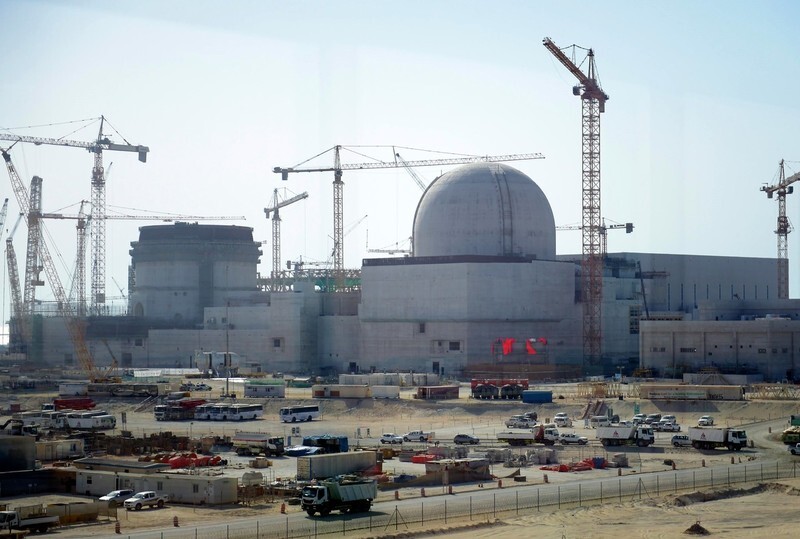hankyoreh
Links to other country sites 다른 나라 사이트 링크
Controversy over Barakah power plant construction fiasco continues

The controversy over the allegedly shoddy construction of the second and third reactors being built by South Korea at the Barakah nuclear power plant in the United Arab Emirates is growing amid the failure of the government and Korea Electric Power Corporation (KEPCO) to provide specifics about the size and number of concrete voids and the places where they were discovered.
The discovery of lubricating grease on the surface of the concrete walls where it was inserted in the third Barakah reactor has some speculating the voids could be quite large. The South Korean government has dismissed the possibility of cracks having formed in addition to voids.
According to an investigation by the Hankyoreh on Dec. 17, the void in the third Barakah reactor were found when bulging occurred in the steel plate surrounding the interior wall of the containment building. The bulging in the plate occurred as grease escaped from cylindrical steel sheath tubing within the building wall and traveled through empty spaces in the wall before gathering at a large gap near the interior wall.
In a Nov. 21 interview with the US energy magazine Energy Intelligence, UAE Federal Authority for Nuclear Regulation (FANR) Director-General Christer Viktorsson said that grease had begun to flow from unexpected places in the third reactor.
A similar issue occurred during construction of the fourth Hanbit reactor in Yeonggwang, South Jeolla Province, in Feb. 1994. According to an official who took part in the investigation at the time, a large void “big enough for a child to fit in” was found when the bulging steel plate was cut to a size of 55 x 4.8 meters and opened.
“You might get some small voids that emerge when the concrete is deposited, but if it’s big enough for grease to gather and cause bulging in the steel, the size could be considerable,” said Han Byeong-seop, director of the Institute for Nuclear Safety and an adjunct professor of atomic energy and energy systems engineering at Dongguk University.
“The seriousness of the issue changes completely depending on the size of the voids,” Han said.
3rd Barakah reactor could have cracks as well as voids
Responding to claims that the third Barakah reactor could have cracks as well as voids, the Ministry of Trade, Industry and Energy (MOTIE) and KEPCO said that voids had been discovered, but cracks had not. They also said the discovery would not have an impact on the completion schedule, with repairs scheduled early next year for the second reactor and within this year for the third.
The discovery of voids in the Barakah reaction was first revealed by KEPCO President Kim Jong-kap in an October parliamentary audit. The possibility of cracks was recently raised as Viktorsson’s remarks about the discovery of grease were reported in South Korea.
By Choi Ha-yan, staff reporter
Please direct comments or questions to [english@hani.co.kr]

Editorial・opinion
![[Column] Park Geun-hye déjà vu in Yoon Suk-yeol [Column] Park Geun-hye déjà vu in Yoon Suk-yeol](https://flexible.img.hani.co.kr/flexible/normal/500/300/imgdb/original/2024/0424/651713945113788.jpg) [Column] Park Geun-hye déjà vu in Yoon Suk-yeol
[Column] Park Geun-hye déjà vu in Yoon Suk-yeol![[Editorial] New weight of N. Korea’s nuclear threats makes dialogue all the more urgent [Editorial] New weight of N. Korea’s nuclear threats makes dialogue all the more urgent](https://flexible.img.hani.co.kr/flexible/normal/500/300/imgdb/original/2024/0424/7317139454662664.jpg) [Editorial] New weight of N. Korea’s nuclear threats makes dialogue all the more urgent
[Editorial] New weight of N. Korea’s nuclear threats makes dialogue all the more urgent- [Guest essay] The real reason Korea’s new right wants to dub Rhee a founding father
- [Column] ‘Choson’: Is it time we start referring to N. Korea in its own terms?
- [Editorial] Japan’s rewriting of history with Korea has gone too far
- [Column] The president’s questionable capacity for dialogue
- [Column] Are chaebol firms just pizza pies for families to divvy up as they please?
- [Column] Has Korea, too, crossed the Rubicon on China?
- [Correspondent’s column] In Japan’s alliance with US, echoes of its past alliances with UK
- [Editorial] Does Yoon think the Korean public is wrong?
Most viewed articles
- 1[Column] Park Geun-hye déjà vu in Yoon Suk-yeol
- 2N. Korean hackers breached 10 defense contractors in South for months, police say
- 3Will NewJeans end up collateral damage in internal feud at K-pop juggernaut Hybe?
- 4[Cine feature] A new shift in the Korean film investment and distribution market
- 5[Editorial] Japan’s rewriting of history with Korea has gone too far
- 6[Column] ‘Choson’: Is it time we start referring to N. Korea in its own terms?
- 7Kim Jong-un expressed ‘satisfaction’ with nuclear counterstrike drill directed at South
- 8[Editorial] New weight of N. Korea’s nuclear threats makes dialogue all the more urgent
- 9[Column] The clock is ticking for Korea’s first lady
- 10Senior doctors cut hours, prepare to resign as government refuses to scrap medical reform plan